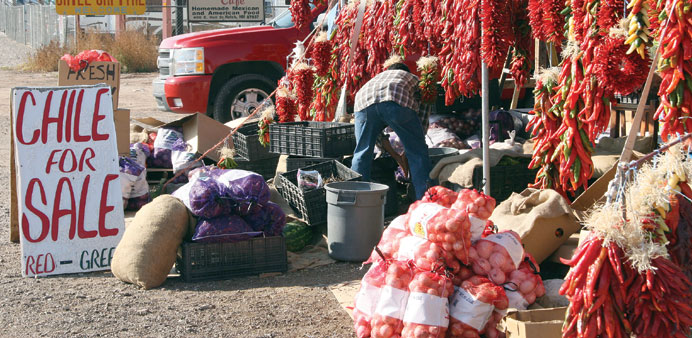A roadside stand sells chilli peppers grown in Hatch, New Mexico and advances the district’s claim to be the US capital of chillis. The product is hung on strings for sale.
By Verena Wolff
The town of Hatch is a pretty sleepy place most of the time. Only about 1,500 people live here and there’s not much going on at the couple of petrol stations, the supermarket or the school.
But there’s one time of year when this town in the south-western US state of New Mexico is really a hot place to be — for the annual Hatch Chile Festival, when Hatch celebrates its status as the chilli pepper capital of the world. (The English spelling of the pepper’s name varies: in Hatch, “chile” is preferred.) This year’s fest is set for August 31-September 1.
“We held the first Chile Festival 41 years ago,” says organising committee head Marcia Nordyke, who has been living in this town on the Rio Grande river for more than 40 years.
“Back then it was meant to show our gratitude to our workers who harvested the chilli pods,” she added. For days the locals cooked the chillis in every variation imaginable and then on Saturday night there was a dance. “Actually all really simple, but nice.”
Today it’s a bit different when, at festival time, not only do people from surrounding towns come to Hatch, but also up to 50,000 people from the rest of the United States and even abroad.
For the occasion, the chilli farmers have spruced up their town and when people turn off the El Paso-Albuquerque highway, the road leading into town is already lined by colourfully-decorated chilli stands. On sale are chilli powders in red and green, ranging in hotness from mild to a mouth-blistering “x-hot”.
Particularly eye-catching is the store of Jim Lytle. He has covered the roof of his general store with hundreds, possibly thousands, of large red chilli pods. Hanging down in front of the door are bunches of chilli peppers of all varieties.
Inside, there are freshly-harvested chillis, dried pods, and ground chilli. Jim owns the Sundown Farm in Salem, a few miles away. There, he and his family grow the crop on 80 hectares of land.
Jim isn’t the boss of the farm. That role is still held by June, otherwise known as “Mama,” who is 88 years old. Her own family came to America from Austria and June is the last of the 10 children. She has known no other life than the chilli fields. “We actually wanted to cultivate grapes for wine, but they didn’t grow here,” she recalled. So, the family tried its luck with chilli — and succeeded. They have even bred their own chilli called “Big Jimmy.”
Farmers like to grow this particular one because the pods are large and tasty. “Today we farm four different types of chilli, but I am constantly experimenting with new cross-breeds,” Jim Lytle says.
New Mexico accounts for about one-third of all the chillis harvested in the United States, including those pods which are immediately roasted and consumed. “Every farmer here eats chilli once a day,” June says. Some even have chilli at every meal.
So what makes the Hatch chillis so special? — “They have a very unique taste of their own, and this has to do with the soil here in the valley,” Jim says. It’s a special soil, so close to the Rio Grande in the New Mexico desert. Jim says he can taste whether a chilli is from Hatch: “They are simply different from those from the northern part of the state or some other country.”
It’s a view shared by Paul Bosland as well. At New Mexico State University in Las Cruces some 70km away, his special area of research is chilli. Together with his students he cultivates his own experimental garden and he breeds various types in a greenhouse.
The aim is to breed a chilli plant that can grow in different climate zones, is resistant to fungi and other diseases, and has pods that are a certain colour.
“We have chillis here from every country you can imagine, since seeds are sent to us from around the world. We grow them here and then study them.”
While chillis have a number of characteristics, farmers are chiefly interested in only one thing — how hot the pods are.
And for this, the standard measurement is SHU — Scoville heat units. It was Wilbur L Scoville, a pharmacologist, who developed the scale 100 years ago. Bosland explains that the hotness of a pod depends on the volume of capsaicins — a compound that is an active component of chilli peppers — in it. “These stimulate the pain receptors in the mucous membranes, letting us taste the spiciness.”
It hasn’t been all that long ago since Bosland bred the hottest chilli pod in the world in his laboratory. The “Bhut Jolokia” measured 1mn SHUs. It is also dubbed the Ghost chilli — the plant’s origin is India, and according to legend, anyone who eats it gives up the ghost. But since then there is another even hotter chilli. “The ‘Trinidad Moruga Scorpion’ has 2mn heat units,” Bosland says.
Anyone who can eat this pod, or a sauce made from it, must either be an experienced chilli freak — or has comparatively dulled taste nerves. “These peppers are hot, and I mean really hot. You’ve got to be extremely careful,” the university researcher says.
But, the peppers have a market, be they destined to become a spice, or an ingredient in marinated dishes or in sauces. “Not only do they taste good to us Americans and Mexicans, but they are also exported around the world,” says a man named Keith, who sells all types of hot and spicy peppers during the Chile Festival.
Fans have their various favourites. Some might like only the red peppers, others only the green ones, and others experiment to see just how much their taste buds can handle. “But it’s not about how hot as possible the food is, but rather that it tastes good,” Keith says.
If it turns out that a chilli pepper is much hotter than expected, then Paul Bosland has a number of useful tips on how to lessen the sting. “Chillis should be enjoyed and not something that hurts,” he says.
But one thing above all: Don’t drink water. “This doesn’t make it any better!” More helpful are dairy products that can lessen the sharpness. The milk fat helps to soothe the mouth and throat area because it dissolves the capsaicin. So a glass of milk or a yoghurt for dessert can bring immediate relief, says the world’s only professor of chilli studies. “Bread can also help.”
While you can take a taste of the festival back home with you by buying some of Keith’s marinades and sauces, at the festival itself there is a special scent in the air — a mixture of all the tasty dishes being served up: burritos, tacos, chili rellenos, and freshly-roasted chillis that the farmers make in their ancient roasting machines. Depending on which type of chilli pod is being roasted and then peeled, the tears may be falling from your eyes.
“That’s totally normal,” says chilli farmer Jim Lytle. He knows his pods, and explains: “When you slice open a chilli lengthwise, you see a long yellow vein. That’s where the hotness is.”
So, for those who are not sure how hot a chilli pepper is, it’s best to taste it at the bottom, where it is the least spicy. “The closer you get to the stem, the hotter it gets,” says Jim.
His sister Sherry Russell knows the best recipes for the hot peppers. At each festival she makes brownies, buttered popcorn and crackers — all spiced with various chillis. And just like Mama and all the other ladies who sell their tasty treats at the festival, she is certain of one thing: chilli makes you addicted.
“Once you get a taste for it, you can’t live without it,” Sherry says. And the best of all is the scent of peppers just as they pop out of the roasting machine. – DPA



